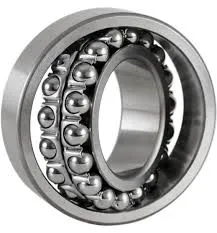
Dec . 26, 2024 04:31 Back to list
small angular contact bearings
The Significance of Small Angular Contact Bearings in Modern Engineering
Small angular contact bearings play a critical role in various engineering applications, primarily due to their ability to manage both axial and radial loads simultaneously. As technology advances and the need for high precision increases, these specialized bearings become indispensable in a range of industries, including aerospace, automotive, manufacturing, and electronics.
Understanding Angular Contact Bearings
Angular contact bearings are designed with raceways that are set at an angle relative to the bearing axis. This design allows them to support axial loads in one direction while accommodating radial loads. The ability to handle mixed loads efficiently makes them ideal for applications where space is limited, yet precision is paramount. The term small in small angular contact bearings generally refers to their dimensions, making them suitable for compact mechanical systems without compromising performance.
Applications of Small Angular Contact Bearings
1. Aerospace The aerospace industry demands the highest standards of performance and reliability. Small angular contact bearings are commonly used in aircraft engines, landing gear mechanisms, and navigation systems, where they contribute to the overall safety and efficiency of the aircraft.
2. Automotive In modern vehicles, small angular contact bearings are vital for various assemblies including transmission gear systems and wheel hubs. Their compact size allows for lightweight designs, which is crucial in the quest for fuel efficiency and performance. Moreover, these bearings ensure smooth operation under varying loads and speeds.
3. Manufacturing Equipment Precision machinery such as CNC machines, lathes, and milling machines utilize small angular contact bearings to maintain accuracy during operation. These bearings provide the necessary stiffness and stability required for intricate machining tasks, ensuring optimal performance and extended lifespan of the equipment.
4. Electronics In the ever-evolving world of electronics, small angular contact bearings facilitate the operation of intricate devices like mobile phones, cameras, and drones. Their ability to minimize friction and maintain high-speed performance is essential in the design of high-tech products that demand precision and reliability.
Advantages of Small Angular Contact Bearings
The design and functionality of small angular contact bearings come with numerous advantages
small angular contact bearings

- High Load Capacity These bearings can handle a combination of radial and axial loads, making them versatile for various applications. - Reduced Friction The optimized design reduces friction, enhancing efficiency and prolonging the lifespan of both the bearing and the machinery it supports.
- Compact Design Small angular contact bearings allow for more compact machine designs, making it easier to integrate within tight spaces while ensuring high performance.
- Precision and Accuracy Their construction enables high-speed operation without compromising on precision, which is crucial for applications requiring tight tolerances.
Challenges and Considerations
While the benefits are significant, several challenges can arise with small angular contact bearings. These include
- Heat Management Higher speeds and loads generate heat, which can affect bearing performance. Proper lubrication and material selection are essential to mitigate thermal effects.
- Installation and Alignment Accurate installation is crucial to ensure optimal performance. Misalignment can lead to premature failure, emphasizing the need for precision during setup.
- Material Selection The choice of materials can impact the performance and durability of small angular contact bearings. Advanced materials such as ceramic or specialized steels are often employed to enhance wear resistance.
Conclusion
Small angular contact bearings are essential components that enable the functionality of numerous machines and devices across various industries. Their ability to efficiently handle both axial and radial loads, coupled with their compact size, makes them invaluable in modern engineering applications. As technology continues to evolve, the demand for precision, reliability, and efficiency will drive further innovations in bearing design and materials, ensuring that small angular contact bearings remain at the forefront of engineering solutions for years to come. The future holds exciting potential for advancements that will not only enhance their capabilities but also expand their applicability in an ever-growing range of technologies.
Latest news
-
Premium Deep Groove Ball Bearings | High Speed & Reliability
NewsAug.29,2025
-
Durable Scaffolding Clamps - Secure & Reliable Tube Connectors
NewsAug.28,2025
-
Common Failures in Thrust Ball Bearings and Solutions
NewsAug.22,2025
-
How Tapered Roller Bearings Can Take Shock Loads
NewsAug.22,2025
-
Angular Bearings in High-Precision Spindles
NewsAug.22,2025
-
The Impact of Misalignment on Cylindrical Roller Bearing Performance
NewsAug.22,2025
